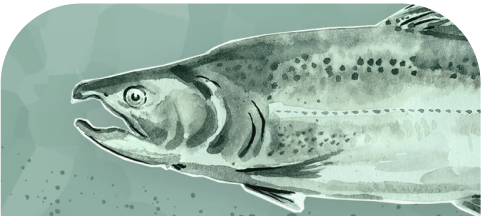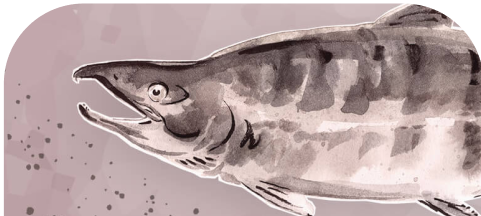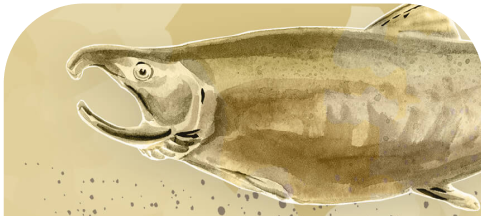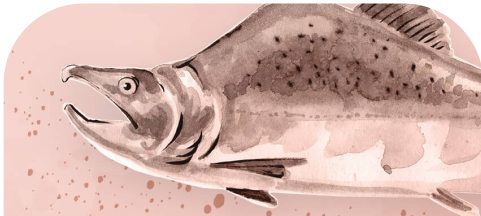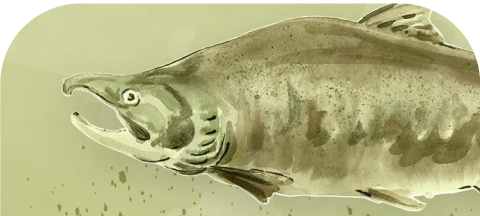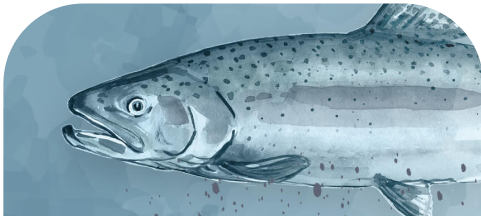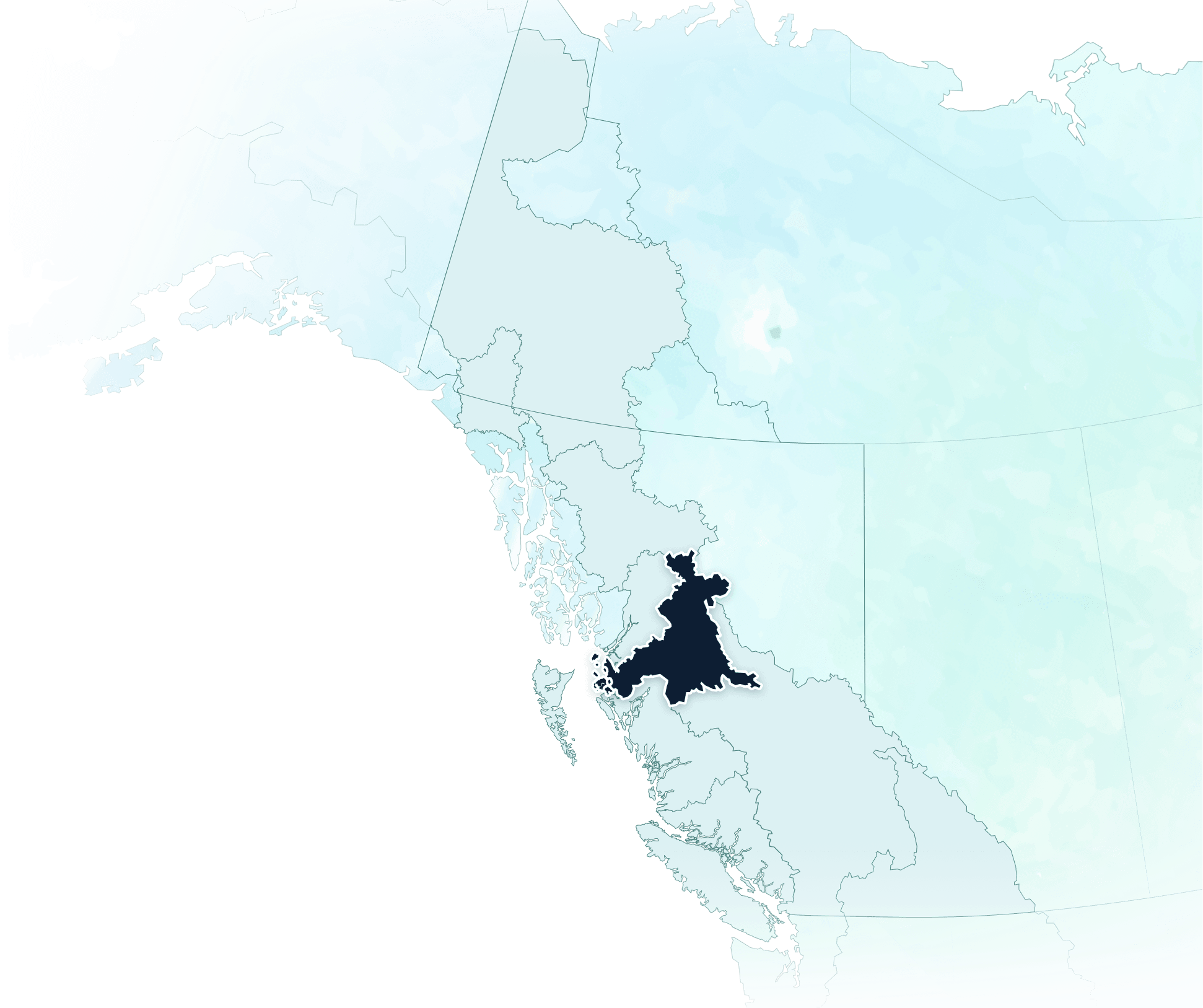Skeena
Chum salmon have declined dramatically, while pink and sockeye spawners are above average
The Skeena is one of British Columbia’s largest salmon-bearing watersheds, second only to the Fraser. Skeena chum salmon are a significant conservation concern. They are the furthest below the long-term average of all species and regions and have a relatively steep negative long-term trend. Skeena chum salmon show no sign of recovery.
Although sockeye spawner abundance is currently above the long-term average, total abundance has remained below average since the mid 2000s.
Salmon enhancement via artificial spawning channels in two tributaries to Babine Lake has led to a century-long erosion of sockeye biodiversity in the region†. The enhanced Babine population now comprises more than 90 per cent of all sockeye returns to the Skeena, with collateral impacts on less abundant populations that are caught in fisheries targeting the enhanced Babine population.


State of Salmon - Skeena
OUR APPROACH
There are different ways to measure the state of salmon, and each approach tells us something unique about how salmon are doing.
CURRENT STATE is the spawner or total abundance over the most recent generation as a per cent anomaly from the long-term average and provides information on how abundant salmon are now relative to past years.
TRENDS measure the direction of change, either over the short-term (most recent three generations) or long-term (all available years). This is complementary information to the current state, and a species that has a declining trend may be a conservation concern even if the current status is above average.
Click on a species for an interpretation of the current state and trends.
Arrows indicate if the trend in abundance is increasing or decreasing
A horizontal line indicates if the trend in abundance is stable
A question mark indicates an unknown current state or trend due to a lack of readily accessible data


SPECIES NOT PRESENT
SPECIES NOT PRESENT
SPECIES NOT PRESENT
SPECIES NOT PRESENT
SPECIES NOT PRESENT
SPECIES NOT PRESENT
SPECIES NOT PRESENT
SPECIES NOT PRESENT
SPECIES NOT PRESENT
SPECIES NOT PRESENT
SPECIES NOT PRESENT
SPECIES NOT PRESENT
How to Interpret this Graph
Each fish above shows the per cent anomaly of current spawner or total abundance over the most recent generation compared to the long-term average (horizontal line) for each region and species.
Interested in more learning more? Check out the Pacific Salmon Explorer for a data-driven look at Pacific salmon Conservation Units and their habitats within each region.
For more details on our assessment approach, view our Methods.
Well-above long-term average. No conservation concern.
Above long-term average. Current outlook is good.
At or near long-term average. Precaution is warranted.
Below long-term average. Current outlook is poor.
Well-below long-term average. Significant conservation concern.
Unknown current state due to a lack of readily accessible data.

REGION PROFILE
Skeena
Conservation Units are irreplaceable groups of salmon that have unique genetic and life-history traits. Maintaining multiple Conservation Units within a region strengthens the resilience of the species as a whole and helps it withstand and adapt to changing conditions. The number of Conservation Units provides a good indication of the salmon biodiversity in the region.
SPECIES NOT PRESENT
Major Salmon-Bearing Rivers
The Skeena River is British Columbia's second largest salmon-bearing watershed, draining an area of 54,432 square kilometers. With its headwaters in British Columbia's northern interior, the 580-kilometre-long river flows southwest to enter the ocean just south of Prince Rupert. Important tributaries within the Skeena River watershed include the Babine River, the Kispiox River, and the Bulkley River.
The Skeena River watershed is one of the most productive salmon watersheds in Canada. All six species of Pacific salmon including steelhead spawn and rear in a diversity of habitats found throughout the watershed, including the Skeena River Estuary and the lower mainstem Skeena River. Salmon habitat is relatively pristine but faces increasing pressures from industrial development.
The Skeena supports Canada’s second largest salmon fishery (second only to the Fraser) and an internationally renowned recreational salmon fishery. In the mid 1960s and early 1970s, two artificial spawning channels were created in two tributaries to Babine Lake - Fulton River and Pinkut Creek - to provide more spawning habitat and boost total sockeye production. Over the past 50 years, these spawning channels have fundamentally changed the composition of salmon populations in the Skeena and eroded the salmon biodiversity of the region†.
Commercial fisheries have been dwindling since the 1990s. In two of the past four years (2019 and 2021), Canadian fisheries for Skeena sockeye have not operated due to low abundances†. More generally, harvest rates of Skeena salmon have been curtailed since the turn of the century to also protect critically low numbers of co-migrating steelhead trout in the Skeena River†. However, harvest for sockeye and also pink salmon in 2022 exceeded the previous 10-year average (2012-2021)†, which - together with above-average spawners for these species - is potentially good news for the region.


